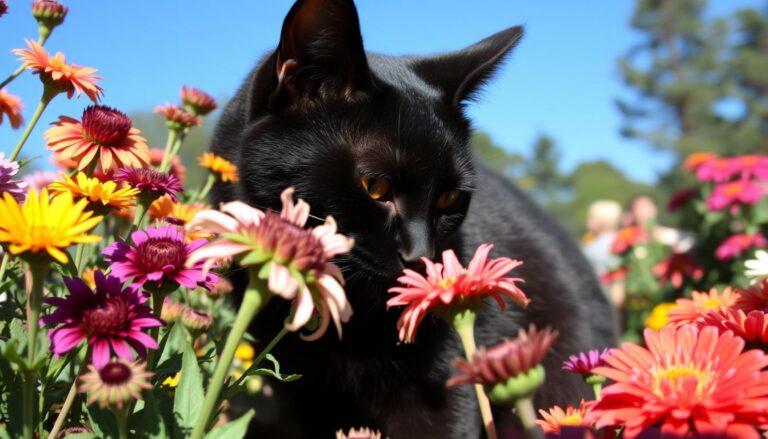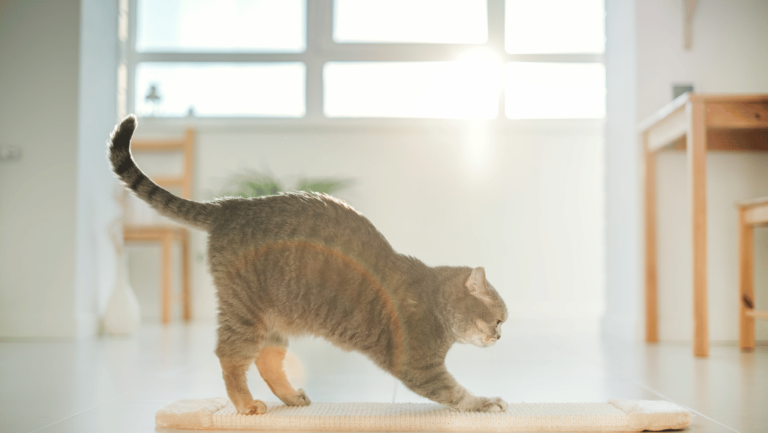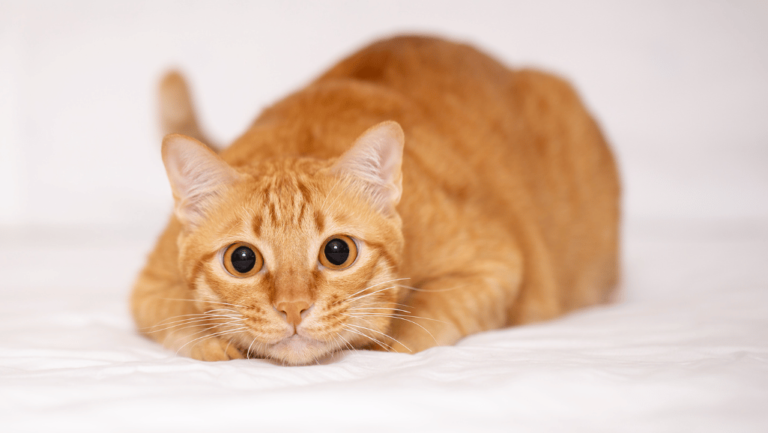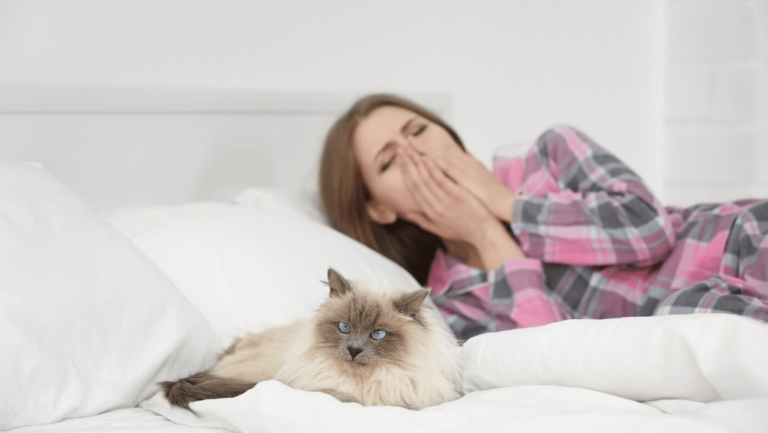As a cat owner, it’s crucial to watch for sick cat symptoms. Changes in your cat’s behavior and looks are often the first signs. You might notice a typically friendly cat becoming quiet if they’re feeling unwell1. Weight changes are also common, with about 27% of cats showing this when they’re sick2.
If your cat has rapid or labored breathing, they could be in trouble. This is seen in 12% of sick cats2. Catching these signs early and getting them to the vet quickly can help a lot. It ensures your cat gets better sooner and stays healthy2.
Key Takeaways
- 14% of cats show signs of illness through dilated or constricted pupils2.
- Changes in sociability, such as becoming withdrawn or clingy, are common3.
- Sudden weight loss or gain is a significant indicator of sickness2.
- Increased lethargy or noticeable decrease in activity can be signs of illness1.
- Respiratory symptoms like rapid breathing affect 12% of sick cats2.
Changes in Behavior
Noticing cat sickness often begins with changes in behavior. These changes can point to health issues that require quick action. Early signs of illness in cats point to the need for a fast diagnosis and treatment.
Becoming Withdrawn or Clingy
A cat that’s more quiet or seeks too much attention might be in pain or discomfort. Sick cats might hide to heal alone or they might be stressed or scared4. You should see the vet as soon as you see these changes5. It’s a good idea for cats to get a check-up once a year to catch problems early6.
Aggression or Fear
If a usually gentle cat starts being aggressive or fearful, it could be in pain or anxious. Sick cats might seem grumpier, less into play, or meow a lot4. These behavioral shifts are big signs something’s wrong and require a vet visit pronto5. Dental issues, which are quite uncomfortable, often cause these behaviors6.
Altered Eating and Drinking Habits
Changes in how much your cat eats or drinks can be big signs of their health. Knowing these signs helps if you’re asking, “How do I know if my cat is sick?” We’ll look at two key changes in a cat’s food and water habits: eating less and drinking more.
Decreased Appetite
If a cat seems less hungry, it might be due to illnesses such as hyperthyroidism or diabetes. Gastrointestinal problems or dental issues can also be the cause7. Not eating for a day could mean they’re feeling sick or have kidney trouble8. Taking care of their teeth is very important, as teeth problems make it hard for cats to eat and drink normally9. If your cat is eating a lot less, it’s time for a visit to the veterinarian.
Increased Thirst
Drinking more water than usual could suggest serious issues like diabetes or kidney disease7. Senior cats often experience more thirst and pee a lot due to chronic kidney disease9. Hyperthyroidism can also make a cat very thirsty because it messes with their metabolism9. Making sure their water is clean and always fresh is a good way to keep them drinking enough.
Here’s a guide to tell if your cat’s habits are okay or if there’s a problem:
| Normal Behavior | Red Flags |
|---|---|
| Regular, consistent eating habits | Significant but sudden decrease in appetite7 |
| Consistent level of thirst | Markedly increased thirst7 |
| Maintaining a healthy weight | Sudden or sustained weight loss8 |
| Normal skin elasticity | Skin not snapping back immediately when pulled8 |
Vomiting and Diarrhea
Spotting feline health warning signs early is key to your cat’s health. Vomiting and diarrhea are big signs to watch out for, especially if they happen a lot.
Chronic Vomiting
It’s okay if your cat throws up now and then. But, if it happens a lot, it’s a warning sign. Chronic vomiting might mean your cat has gastroenteritis. This issue can come from infections, eating something bad, or even tumors10.
Tests like blood work, serum chemistry, and x-rays can check for this issue. If your cat can’t stop vomiting, it can get serious fast. Dehydration and body chemical problems can happen10.
There are things like plants, antifreeze, and chemicals that make cats vomit11. But, it could also be from issues like inflammatory bowel disease or food allergies11.
Your vet might give your cat fluids and drugs to help, depending on the cause1012. Good health checks can catch these problems early12.
Frequent Diarrhea
If your cat keeps having diarrhea, it’s a worry. This can be a sign of gastroenteritis, which includes diarrhea, stomach pain, and tiredness12.
Diarrhea could come from infections, tumors, or eating toxic things10. Even health conditions like hyperthyroidism or food issues might cause it11.
Diarrhea can quickly dehydrate cats if it doesn’t stop after a day10. If this happens, it’s time to see the vet. They can check what’s wrong and start treatment to balance your cat’s body1012.
Preventing digestive upsets includes slowly changing your cat’s food. Also, keeping dangerous things out of their reach can make a big difference12.
Looking out for issues like vomiting and diarrhea is very important. Getting help from the vet early can keep your cat healthy.
Respiratory Symptoms
If your cat has trouble breathing, like coughing or wheezing, they might have an upper respiratory infection. This kind of issue is very common and needs quick care. Scheduling a vet visit when you see these signs can help a lot.
Coughing and Wheezing
Coughing and wheezing rule out more serious issues. A lot of the time, upper respiratory infections are behind it. They often come from viruses, including feline herpesvirus and feline calicivirus13. These bugs can cue bacterial infections, making things worse for your cat.
If your cat came from a tight place, like a shelter, they could be at high risk. The risk of feline calicivirus in these places is up to 90%14. And, about two-thirds of cats won’t make it if they get the systemic calicivirus infection14. So, seeing a vet as soon as you spot these signs is key.
Labored Breathing
Labored breathing or dyspnea means your cat might face several health issues. This could be from infections, breathing in fungi, or from something long-term. Cats that roam outside may pick up infections from other cats or from nature13. Experts suggest tests like blood work, cultures, and X-rays to pinpoint what’s causing the trouble13.
Their treatment might involve medicine, keeping them away from other cats, rest, and special foods. All these steps aim for a full recovery for your furry friend13.
Changes in Activity Level
It’s key to watch how active your cat is. Changes in their usual routines might mean they’re sick. This is a warning to get them checked by a vet.
Lethargy and Fatigue
Cats acting lazy or tired might be sick. This could be due to infections or stress. If a cat seems less lively or tired, it could be a sign of problems like inflammation or organ issues.
Getting regular check-ups can catch these problems early, helping the cat feel better.
Decreased Playfulness
Not wanting to play and avoiding people are big red flags for illness. If a cat suddenly stops playing or seems bored with toys, they might be sick. Possible causes include tooth pain or chronic conditions.
If you notice a change in your cat’s play habits, it’s wise to see a vet.
Sudden Hyperactivity
On the flip side, sudden hyperactivity can point to health issues like hyperthyroidism. Unusually high energy in a cat shouldn’t be ignored. It’s a sign that something could be wrong and a vet visit is needed15. Changes in grooming or loud meowing may also suggest they’re unwell.
Watching for these signs of illness can lead to timely care. This can make a big difference in the cat’s happiness and health.
Changes in Grooming Habits
It’s important to watch how your cat grooms. This can help recognize sickness early. If your cat stops grooming as usual, it might be a sign of health problems or stress16.
Neglecting Grooming
Cats that don’t groom themselves might be sick. Older cats tend to groom less. They might have a dull coat, dandruff, or matted fur17. Stress or illness can make a cat avoid grooming, looking messy with possible skin problems16. It’s not safe to ignore changes in how your cat grooms. These changes could signal major health issues needing a vet.
Over-Grooming and Hair Loss
On the other hand, cats that groom too much might be sick too. They could over-groom because of stress, skin problems, or pain. This can cause them to lose hair, getting bald spots1618. Over-grooming often links to anxiety or stress that needs to be resolved. Your cat could also be trying to tell you it’s in pain by this behavior18.
Keeping an eye on your cat’s grooming can do wonders for their well-being and health.
Recognizing Weight Changes
One big sign of illness in cats is a change in weight. Spotting these changes early can really help your cat’s health. Both sudden weight loss and quick weight gain need careful watching and a trip to the vet.
Unexpected Weight Loss
Cats losing weight without a clear reason is worrying. It could mean they have hyperthyroidism, diabetes, or kidney issues519. Changes in weight may also point to problems with metabolism or hormones20. If your cat stops eating, call the vet right away. Even missing meals for a short time can cause a serious liver illness20.
Rapid Weight Gain
Rapid weight gain isn’t good news either and could signal health concerns like diabetes or hyperthyroidism19. A stronger appetite might show problems like inflammatory bowel disease or cancer5. This sudden or unexplained weight gain needs close watch20. Cats are good at hiding their sickness, so we have to be extra careful19.
| Condition | Symptom | Potential Cause |
|---|---|---|
| Weight Loss | Loss of appetite | Hyperthyroidism, diabetes19 |
| Weight Gain | Increased appetite | Inflammatory bowel disease, cancer5 |
| Rapid Weight Gain | Consistent weight increase | Diabetes, metabolic imbalance20 |
What are the signs that my cat is sick?
To keep your cat healthy, it’s vital to notice signs of sickness early. This way, you can get your furry friend the help they need. We’ll cover common signs that your cat may be sick and when to see the vet.
Common Symptoms to Watch For
Cats can hide their pain well. So, it’s up to you to look for changes in their behavior. Loss of appetite for over two days or sudden excessive scratching might mean they’re not feeling well21.
Other not-so-obvious signs can include:
- Drinking a lot of water could point to serious diseases like diabetes or hyperthyroidism2122.
- If your cat suddenly looks messy or their fur is a mess, this could also be a symptom of a problem23.
- Vomiting often (more than two days in a row) might hint at liver issues or something blocking their gut23.
- They could be in pain if they start meowing much more than usual, or if they avoid you23.
- Trouble using stairs could be a sign of problems with their joints or muscles21.
Watch for these symptoms. They’ll help you figure out if your cat is sick. Then, you can act fast.
When to Visit the Vet
Sometimes, it’s critical to get your cat to the vet as soon as possible:
- If they seem to be in a lot of pain, are having seizures, or have trouble breathing22.
- Vomiting blood, not moving, or not being able to walk need immediate attention22.
- If they keep throwing up and are not eating, they could be dehydrated, which is very serious23.
Spotting signs of illness early and contacting your vet right away can save your cat’s life.
Common Causes of Illness in Cats
It’s key for cat owners to know the main reasons for sickness in their pets. This helps to find and treat problems early, stopping serious issues later.
Infections and Parasites
Infections and parasites are big reasons behind cat illnesses. For instance, fleas make cats scratch a lot and feel uncomfortable. It’s important to treat both the cat and its living space to keep these bugs away24.
Worms can cause itching and stomach problems. A vet should treat this quickly to prevent spread24. Then there’s cat flu, which is a virus just for cats. It can make their nose run, their eyes sore, and can be deadly if not vaccinated against24.
Chronic Diseases
Chronic diseases really affect a cat’s quality of life. Lymphosarcoma, a type of cancer, causes about 30% of cat cancer cases25. Diabetes is often linked to obesity, being a male, or getting older25.
Cats drinking more water than normal might have kidney, thyroid, or diabetes issues26. Feline leukaemia spreads through close contact and can lead to breathing and stomach problems24.
Poisoning and Injuries
Poisoning and injuries are risks too. Cats can get poisoned by household products or plants. This can lead to tummy troubles, brain symptoms, and sometimes death. Watch for any signs after an accident.
Staying alert to these signs helps keep cats healthy. Regular check-ups, the right weight, a good diet, and vaccinations protect them from harm24.
Changes in Litter Box Habits
It’s key to notice changes in your cat’s litter box habits. If your cat has trouble peeing or pooping, or they do it more often, something could be wrong. These changes might point to serious health troubles, so let’s look at them closely.
Difficulty Urinating or Defecating
If your cat has a hard time using the litter box, they might be sick. Issues could include urinary tract infections, kidney problems, or just being constipated. Watch if they seem to struggle, make noise, or avoid the litter box. Older cats or those with move issues might find some litter boxes tough to use, adding to the problem27.
Increased Frequency
If your cat is peeing or pooping more than usual, it could be serious. Things like cystitis, which is a sore bladder, could be the cause. Stress can also lead cats to go outside the box. This might be triggered by big changes at home or health issues like arthritis. Keeping an eye on their habits with the right number of litter boxes is smart4.
Signs of a Urinary Blockage
Finding cat sickness early can save its life. Signs include going to the litter box without results, crying in pain, or licking the private parts too much. This hints at a urinary blockage, a serious condition needing a vet right away. Having enough litter boxes for each cat plus one more helps you notice these problems quickly28.
Symptoms Affecting the Eyes and Nose
When cats have health issues, their eyes and nose often show it first. You might see eye discharge, redness, and they might have trouble breathing through their nose. Catching these signs early is key to prevent big health issues later.
Eye Discharge and Redness
If your cat’s eyes look cloudy, have any discharge, or their pupils are different sizes, there could be a problem29. A red or swollen third eyelid might mean they’re sick30. If their eyes keep leaking or looking red, it’s time to see a vet. This could save their sight from getting worse.
Nasal Discharge and Sneezing
Sneezing with watery eyes often points to a cold in cats31. If their nose runs clear, it’s probably a virus. But thick, colored mucus or a lot of sneezing could mean a bacterial infection.
Bringing a new cat home can cause these symptoms too. Watch for them about a week after the new arrival, due to stress31. Then, make sure they get checked by a vet on time.
Conclusion
It’s crucial to know and spot cat illness symptoms for the good of our pet cats. When they’re sick, cats show many signs. They might act differently or have physical changes. More meowing or sudden weight loss could mean they have health problems like diabetes or nerve issues, which need a vet’s check32. If they eat or drink differently, like being very thirsty or not wanting food, it could be a sign of diabetes or thyroid problems32.
It’s very important to seek vet help when symptoms are serious. Like, a male cat trying hard to pee might be facing a big health issue that needs immediate care33. Also, stress can make cats sick. It might cause them to throw up or not move much34. A calm setting and fun things to do can help a lot. Even cats with bad problems like feline interstitial cystitis can get better this way34.
Knowing signs like heavy vomiting, hard breathing, or a lot of grooming can mean your cat needs help fast. Combining mental activities with vet care is key. With you paying close attention and vet help, your pet’s life can get much better. This way, they can have a longer, happier life.














